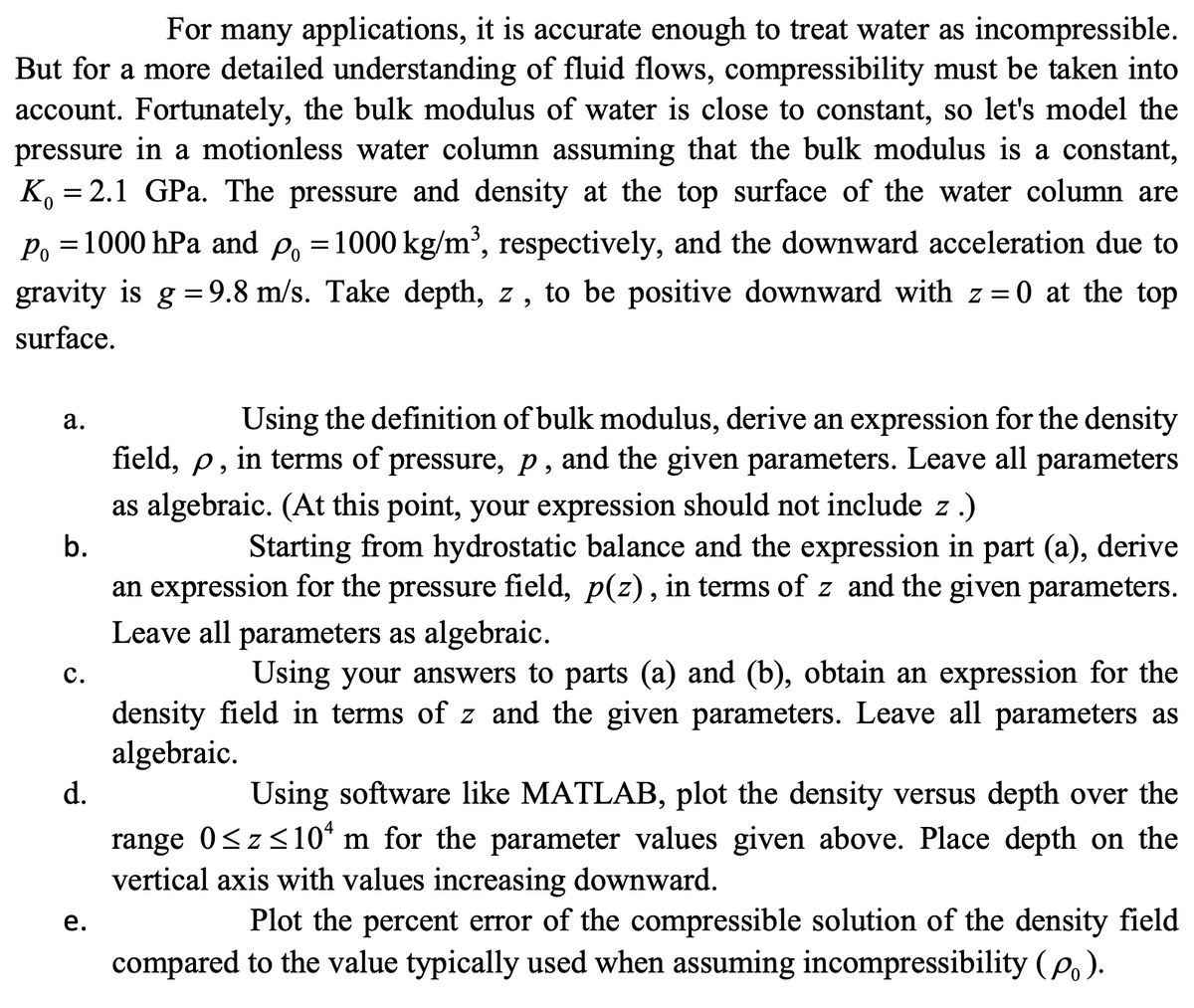For many applications, it is accurate enough to treat water as incompressible. But for a more detailed understanding of fluid flows, compressibility must be taken into account. Fortunately, the bulk modulus of water is close to constant, so let's model the pressure in a motionless water column assuming that the bulk modulus is a constant, K, = 2.1 GPa. The pressure and density at the top surface of the water column are Po = 1000 hPa and p =1000 kg/m³, respectively, and the downward acceleration due to gravity is g =9.8 m/s. Take depth, z , to be positive downward with z=0 at the top %3| %3D surface. Using the definition of bulk modulus, derive an expression for the density in terms of pressure, p, and the given parameters. Leave all parameters а. field, p, as algebraic. (At this point, your expression should not include z .) Starting from hydrostatic balance and the expression in part (a), derive an expression for the pressure field, p(z), in terms of z and the given parameters. b. Leave all parameters as algebraic. с. Using your answers to parts (a) and (b), obtain an expression for the density field in terms of z and the given parameters. Leave all parameters as algebraic.
For many applications, it is accurate enough to treat water as incompressible. But for a more detailed understanding of fluid flows, compressibility must be taken into account. Fortunately, the bulk modulus of water is close to constant, so let's model the pressure in a motionless water column assuming that the bulk modulus is a constant, K, = 2.1 GPa. The pressure and density at the top surface of the water column are Po = 1000 hPa and p =1000 kg/m³, respectively, and the downward acceleration due to gravity is g =9.8 m/s. Take depth, z , to be positive downward with z=0 at the top %3| %3D surface. Using the definition of bulk modulus, derive an expression for the density in terms of pressure, p, and the given parameters. Leave all parameters а. field, p, as algebraic. (At this point, your expression should not include z .) Starting from hydrostatic balance and the expression in part (a), derive an expression for the pressure field, p(z), in terms of z and the given parameters. b. Leave all parameters as algebraic. с. Using your answers to parts (a) and (b), obtain an expression for the density field in terms of z and the given parameters. Leave all parameters as algebraic.
Chapter2: Loads On Structures
Section: Chapter Questions
Problem 1P
Related questions
Question

Transcribed Image Text:For many applications, it is accurate enough to treat water as incompressible.
But for a more detailed understanding of fluid flows, compressibility must be taken into
account. Fortunately, the bulk modulus of water is close to constant, so let's model the
pressure in a motionless water column assuming that the bulk modulus is a constant,
K, = 2.1 GPa. The pressure and density at the top surface of the water column are
6.
Po =1000 hPa and P, =1000 kg/m², respectively, and the downward acceleration due to
gravity is g =9.8 m/s. Take depth, z, to be positive downward with z = 0 at the top
%3D
%3D
%3D
surface.
Using the definition of bulk modulus, derive an expression for the density
field, p, in terms of pressure, p, and the given parameters. Leave all parameters
а.
as algebraic. (At this point, your expression should not include z .)
b.
Starting from hydrostatic balance and the expression in part (a), derive
an expression for the pressure field, p(z), in terms of z and the given parameters.
Leave all parameters as algebraic.
с.
Using your answers to parts (a) and (b), obtain an expression for the
density field in terms of z and the given parameters. Leave all parameters as
algebraic.
d.
Using software like MATLAB, plot the density versus depth over the
range 0<z<10* m for the parameter values given above. Place depth on the
vertical axis with values increasing downward.
Plot the percent error of the compressible solution of the density field
compared to the value typically used when assuming incompressibility (po).
е.
Expert Solution
This question has been solved!
Explore an expertly crafted, step-by-step solution for a thorough understanding of key concepts.
Step by step
Solved in 4 steps

Knowledge Booster
Learn more about
Need a deep-dive on the concept behind this application? Look no further. Learn more about this topic, civil-engineering and related others by exploring similar questions and additional content below.Recommended textbooks for you


Structural Analysis (10th Edition)
Civil Engineering
ISBN:
9780134610672
Author:
Russell C. Hibbeler
Publisher:
PEARSON

Principles of Foundation Engineering (MindTap Cou…
Civil Engineering
ISBN:
9781337705028
Author:
Braja M. Das, Nagaratnam Sivakugan
Publisher:
Cengage Learning


Structural Analysis (10th Edition)
Civil Engineering
ISBN:
9780134610672
Author:
Russell C. Hibbeler
Publisher:
PEARSON

Principles of Foundation Engineering (MindTap Cou…
Civil Engineering
ISBN:
9781337705028
Author:
Braja M. Das, Nagaratnam Sivakugan
Publisher:
Cengage Learning

Fundamentals of Structural Analysis
Civil Engineering
ISBN:
9780073398006
Author:
Kenneth M. Leet Emeritus, Chia-Ming Uang, Joel Lanning
Publisher:
McGraw-Hill Education


Traffic and Highway Engineering
Civil Engineering
ISBN:
9781305156241
Author:
Garber, Nicholas J.
Publisher:
Cengage Learning